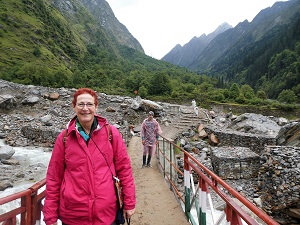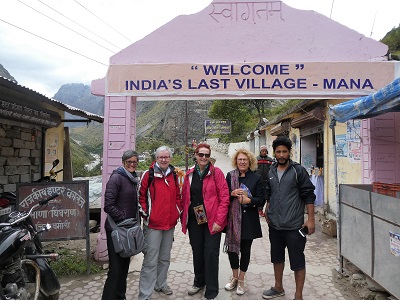BACK DOWN THE MOUNTAIN AND ONWARDS TO BADRINATH AND MANA (Story 4)

And so, time to leave

It rains heavily all night but in the morning the rain stops and we are left with the mystical cloudy scenes which are awesome and beautiful. We pack up and leave after an early breakfast to walk back down to the jeeps and Govind Ghat.

It takes only 2 hours and 45 minutes to make the return journey but we do have to be quite careful on the very slippery stone path as the rain comes and goes in showers of heavy drizzle.

The river is gushing brown and loud as it rushes to the valley floor and this is a timely reminder of the power of water and how destructive it can be when unleashed; such as happened in 2013.


From Govind Ghat, where we again meet up with our diver, we drive the 25km to Badrinath. This road, when I was last there in 2014, was a disaster, but today it is much better, still under repair by ‘road workers’ some of whom are mothers with children. They live in makeshift camps along the roadside and cook in pressure cookers over open wood fires on the ground – totally amazing!


Badrinath temple

Badrinath is again as beautiful as ever although a bit wet. We book into our hotel and soon set off towards the town for lunch and then a visit to the temple. Normally we would walk but today due to the rain our driver takes us to a car park. This is an amazing driving feat to get to this car park in an ancient town with narrow roads and little parking space. After a nice lunch, we walk down towards the river raging under the bridge with rain overhead and umbrellas to keep us dry. We park our shoes at the shop of a man we had met previously in 2014 (it is amazing that we easily find him again in the maze of narrow lanes and shops that spread out from the temple complex). Suresh and Kartik go to have a ceremonial dip in the hot pools but we girls decide it is too wet and miserable. When they come back, they tell us the water is too hot and they could not get in.

We enter the temple grounds which are busy with pilgrims meditating in the outer courtyard and awaiting their turn to move into the temple for the blessing. It is high season for the pilgrimages here. We sit and meditate until Suresh arrives and we are directed to stand in a line that is very slow moving. Soon Suresh takes us around the front of the temple and, due to time, rather than entering the temple we view the sanctum and inner sanctum from a platform at the front doors where the inner walls glimmer with their silver linings of pressed silver impressions and intricate carvings. Today I feel they shine even more brightly than I have seen them before and, even though I have been in the inner sanctum in the past, this was a magnificent and powerful viewpoint and I feel blessed and satisfied with my visit here. Badrinath has a long and wonderfully amazing history and legend Read more about Badrinath Temple here
Badrinath is a Vishnu temple and one of the celebrated pilgrim sites – one of the 4 ‘char darms’ – places of worship where Hindus aspire to get to in their lifetime to help attain moksha, otherwise known as liberation or enlightenment. It stands above the Alaknanda river where sulphur baths and hot pools occur naturally on its banks. The Nilkintha peak rises 6,596m (21,640ft) behind the temple and towers above the valley.

Although not the highest in the region, it is affectionately known as ‘blue throat’ and noted as a Shiva epithet, it begs to be photographed and has only been climbed a few times according to read about Nilkintha mountain climbs here
resisting its climbers with its steep ridges and faces since the first attempt in the 1930s. The controversy around the first recognised ascent in 1961 was followed by the generally accepted first ascent as recent as 1974.

The surrounding mountains and Mana village
Many high mountains surround this beautiful valley and we admire them as we drive the 3km to Mana village, the last remaining Indian village on this road which is only about 50km from the Tibetan Border.

The villagers of this very quaint town, with its narrow cobbled streets, are ‘Tibetan, Mongolian, Indian’ and this is the only village where this mix of people live. Their features are Tibetan-Mongolian rather than Indian and they raise Angora goats, sheep, and cows, as well as growing many vegetables, herbs, and lots of potatoes. Wearing traditional dress and very shy, they sell the wool from the animals they raise in the form of hats, socks, rugs, and scarves either knitted or woven.


They sit in the sunshine outside their mud brick, slate-roofed houses with wooden balconies. It is such a pleasure to purchase the beautiful handmade garments from the locals as they weave and knit right there on the balconies and porches of their homes and shops. Traditionally each time I have visited here I have bought a hat for my son – the previous ones since 2003 have never worn out, so he now has a nice collection. I still have the socks I purchased in 2003 and they are super warm and comfy. This year I purchase a nice woven rug for Manfred to keep him warm during his meditations.

We visit the stone bridge which legend from the Mahabharata tells; Bheem, one of four Pandava brothers, laid a huge rock across the gap over the Saraswati River, with its raging water far below, so as to cross the narrow gut in the rocks, towards the ‘path to Heaven’.

This path runs up the valley towards the Vasudhara falls (visited in 2014) and on through the high and remote Himalayas. These days this path is used by trekking groups, a path used by yogis, saints, and sages for thousands of years.



A visit to a very old cave temple
Climbing up a narrow twisting path in the opposite direction, we visit the 5325-year-old Vyasa Gufa cave temple. This is where Ved Vyas put together the great epic of the Vedas having been aware of them for 300 years before they were ‘given’ to him. This might sound a little fantastical, but when you visit the high Himalayas, you can see that nothing is impossible and everything is possible in this ancient land where legends and truth meld in a symphony of amazing stories played out in theatre, places of learning, and yoga schools all across India and the world.

We enter the temple where the priest is offering blessed food (Prasad) to the flow of pilgrims. We sit to meditate for a short time in front of the very old statue of Ved Vyas and a newer one which sits alongside the old. Of course, as in many temples, here in the holy enclave of this temple, we cannot take photos, but commit our experience to memory. The priest blesses the pilgrims with the familiar chant of ‘Hari Om’ as he places some sandalwood paste on their forehead. Phyllis asks if he gives blessings and immediately he sprouts forth a long passage of blessing in Sanskrit before placing Sandalwood paste on our foreheads too. It is a beautiful experience and I still wear the blessing string he placed around my left wrist. It is now some months later that I get to write this and there is no sign of it wearing or fading. The priest chats to Suresh, who is well known to him from taking other groups there, and Suresh introduces Kartik, his son, to the priest. Interestingly, while the priest is reciting the Sanskrit blessing and talking with us, no other pilgrims come into the cave – just an observation I had at that time. Once he finishes, the line of pilgrims starts again.

We leave the cave, taking photos outside, and walk down another narrow stone path to a smaller Ganesha Cave. The temple sits partially inside the small cave, so being careful not to knock our head on the roof and sides we do a respectful 3 rounds (Kora). At this spot, Ganesha is said to have scribed the Mahabharata for Ved Vyas as he recited the stanzas one after another.

Read further here – a good article from 2012. Read more here
Just as we reach the car the rain starts again. We rest well that night after a big day coming down from the Valley of Flowers, visiting the Badrinath temple and Mana village with all the very wonderful mountain scenes and sensorial beauty.

#gangaria #Himalayanadventures #Himalayas #India #lettheadventurebegin #mistymountains #Travel #traveltheworld #valleyofflowers #valleyofflowersindia #worldtraveler #manavillage #badrinath #india #badrinahttemple #nilkinthapeak #shivabluethroatmountain


Beautifully described!
Thankyou, I appreciate your comment. kind regards – I hope you enjoy the other stories also. 🙂